Mises, Ludwig von. Human Action: A Treatise on Economics
Подождите немного. Документ загружается.

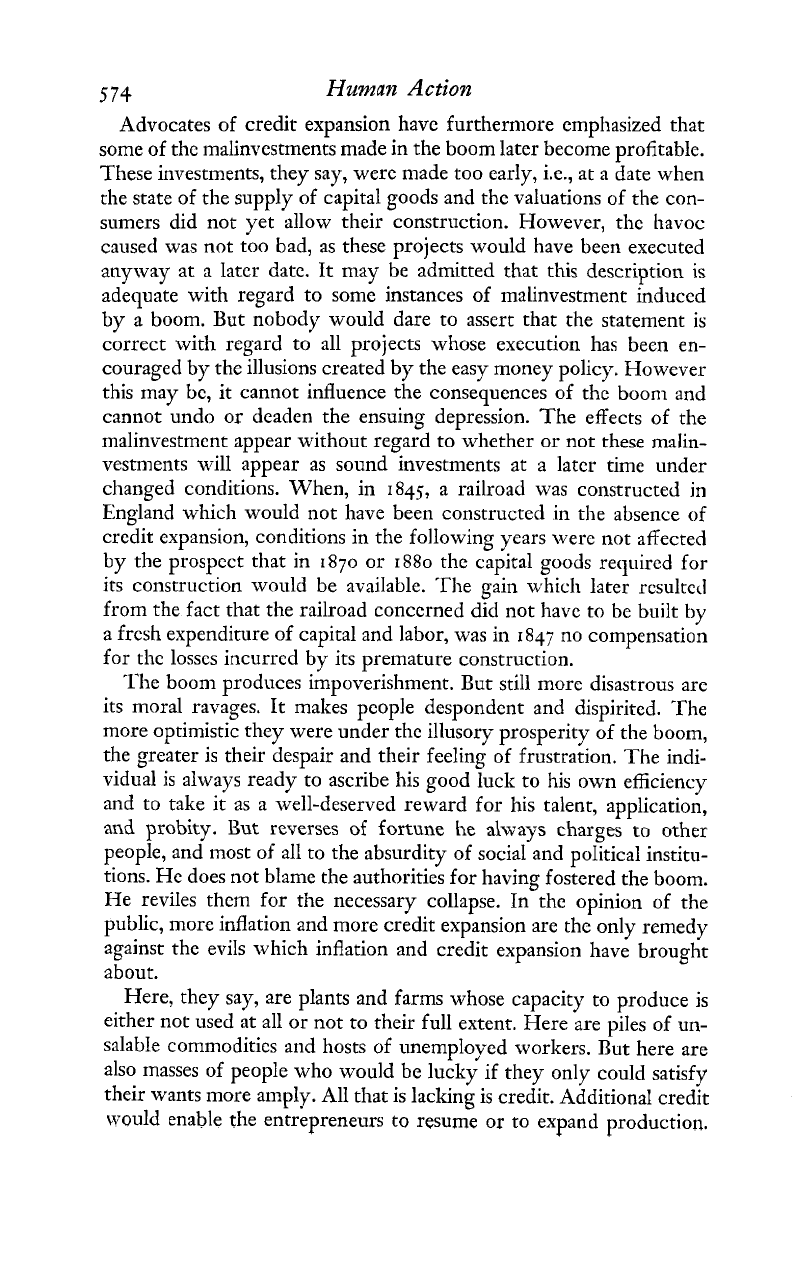
5
74
Human
Action
Advocates of credit expansion have furthermore emphasized that
some of the malinvestments made in the boom later become profitable.
These investments, they say, were made too early, i.e., at a date when
[he state of the supply of capital goods and the valuations of the con-
sumers did not yet allow their construction. However, the havoc
caused was not too bad, as these projects would have been executed
anyway at a later date. It may be admitted that this description
is
adequate with regard to some instances of rnalinvestment induced
by
a
boom. But nobody w-ould dare to assert that the statement is
correct with regard to all projects whose execution has been en-
couraged by the illusions created by the easy money policy. However
this may be, it cannot influence the consequences of the boom and
cannot undo or deaden the ensuing depression. The effects of the
rnalinvestment appear without regard to whether or not these malin-
vestments will appear as sound investments at a later time under
changed conditions. When, in 1845, a railroad was constructed in
England which would not have been constructed in the absence of
credit expansion, conditions in the following years were not affected
by
the prospect that in 1870 or 1880 the capital goods required for
its construction would be available. 'The gain which later resulted
from the fact that the railroad concerned did not have to be built
by
a frcsh expenditure of capital and labor, was
in
1847 no compensation
for the losses incurred by its premature construction.
'She boom produces impoverishment. But still more disastrous are
its moral ravages. It makes people despondent and dispirited. The
more optimistic they were under the illusory prosperity of the boom,
the grcater is their despair and their feeling of frustration. The indi-
vidual is always ready to ascribe his good luck to his own efficicncy
and to take it as a well-deserved reward for
his
talent, application,
and
probity.
But
reverses
of
fortune he always charges
to other
people, and most of all to the absurdity of social and poIitica1 institu-
tions. He does not blame the authorities for having fostered the boom.
He reviles them for the necessary collapse. In the opinion of the
public, more inflation and more credit expansion are the only remedy
against the evils which inflation and credit expansion have brought
about.
Here, they say, are plants and farms whose capacity to produce is
either not used at all or not to their full extent. Here are piles of un-
salable commodities and hosts
of
unemployed workers. But here are
also masses of people who would be lucky if they only could satisfy
their wants more amply. All that is lacking is credit. Additional credit
would enable the entrepreneurs to resume or to expand production.
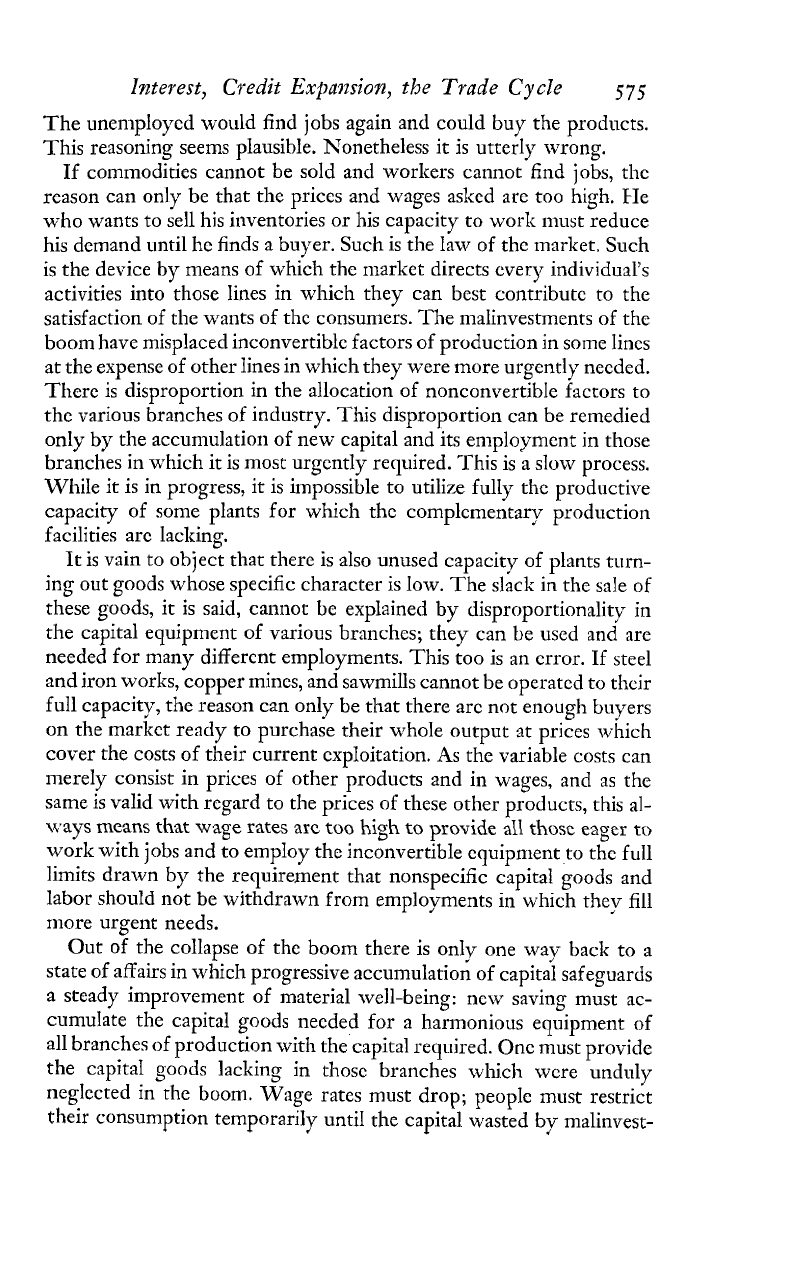
Inte~est, Credit Expmion, the Trade Cycle
575
The unemployed would find jobs again and could buy the products.
This reasoning seems pIausible. Nonetheless it is utterly wrong.
If commodities cannot be sold and worlters cannot find jobs, the
reason can only be that the prices and wages asked are too high. He
who wants to sell his inventories or his capacity to work must reduce
his demand until he finds a buyer. Such is the law of the market. Such
is the device by means of which the market directs every individual's
activities into those lines in which they can best contributc to the
satisfaction of the wants of the consumers. The malinvestments of thc
boom havc misplaced inconvertible factors of production in some lines
at the expense of other lines in which they were more urgently needed.
Thcrc is disproportion in the allocation of nonconvertible factors to
thc various branches of industry. This disproportion can be remedied
only by the accun~ulation of new capital and its enlployment in those
branches in which it is most urgently required. This is a slow process.
While it is in progress, it is
impossible
to utilize fully the productive
capacity of some plants for which the complcmentary production
facilities are lacking.
It
is vain to object that there is also unused capacity of plants turn-
ing out goods whose specific character is low. The slack in the sale of
these goods, it is said, cannot be explained by disproportionality in
the capital equipment of various branches; they can be used and are
needed for many different employments. This too is an error. If steel
and iron works, copper mines, and sawmills cannot be operated to their
full capacity, the reason can only be that there arc not enough buyers
on the market ready to purchase their whole output at prices which
cover the costs of their current exploitation. As the variable costs can
merely consist in prices of other products and in wages, and as the
same is valid with rcgard to the prices of these other products, this al-
ways means that
wage
rates arc too high to provide all those eager
to
work with jobs and to employ thc inconvertible equipment to the full
limits drawn
by
the requirement that nonspecific capital goods and
labor should not be withdrawn from employments in which they fill
more urgent needs.
Out
of
the collapse of the boom there is only one way back to a
state of affairs in which progressive accumulation of capital safeguards
a steady improvement of material well-being: ncw saving must ac-
cumulate the capital goods needed for a harmonious equipment of
all branches of production with the capital required. One must provide
the capita1 goods lacking in those branches which were unduly
neglected in the boom. Wage rates must drop; people must restrict
their consumption temporarily untiI the capital wasted by malinvest-

576
Human
Action
ment is restored. Those who dislike these hardships of the readjust-
ment period must abstain in
time
from credit expansion.
There is no use in interfering by means of a new credit expansion
with the process of readjustment. This would at best only interrupt,
disturb, and prolong the curative process of the depression, if not
bring about a new boom with all its inevitable consequences.
The process of readjustment, even in the absence of any new
credit expansion, is delayed by the psvchological effects of disap-
pointment and frustration. People are ;low to free themselves from
the self-deception of delusive prosperity. Businessmen try to continue
unprofitable projects; they shut their eyes to an insight that hurts. The
workers delay reducing their claims to the level required by the state
of the market; they want, if possible, to avoid lowcring thcir standard
of living and changing their occupation and their dwelling place.
People are the more discouraged the greater their optimism was in
the days of the upswing. They have for the moment lost self-
confidence and the spirit of enterprise to such an extent that they even
fail to take advantage of good opportunities. But the worst is that
people are incorrigible. After
a
few years they embark aneu7 upon
credit expansion, and the old story repeats itseif.
The
Role Pla.yed
by
U?2ewzploycd Fxctors of Production
in
the
First Stages of
n
Boom
There are in the changing economy always unsold inventories (exceed-
ing those quantities which for technical rcasons must be lrcpt in stock),
unemployed workers, and unused capacity of inconvertible production
facilities. The system is moving toward a state in which there wilI be
neither
unemployed
workers nor surpIus inventories.14 But as the ap-
pearance of new data continualIy diverts the course toward
a
new goal, tht.
conditions of the evenly rotating economy are never realized.
The presencc of unuscd capacity of inconvertible investnlents is an out-
growth of errors committed in the past. Thc assumptions made by the in-
vestors were, as later events proved, not correct; thc market asks more
intensively for other goods than for those which these plants can turn out.
The piIing up of excessivc inventories and the catallactic uncmployment
of workers are speculative. The owner of the stock refuses to seIl at the
market price because he hopcs to obtain a higher price
at
a later date. The
unemployed worker refuses to change his occupation or his residence or
to content himself with lower pay because he hopes to obtain at a later date
a
job
with higher pay in the place of his rcsidence and in thc branch of busi-
ness he likes best. Both hesitate to adjust their claims to the present situation
14.
Tn
the
evenly rotating economy also there may
bc
unused capacity of in-
convertible equipment. Its nonutilization does not disturb the equilibrium any
more than
the
fallowness of submarginal soil.

Interest,
Credit
Expansion,
the
Trade
Cycle
577
of the market because they wait for a change in the data which will alter
conditions to their advantage. Their hesitation is one of the reasons why
the system has not reached the state of the evenly rotating economy.
The advocates of credit expansion argue that what is wanted is more
fiduciary media. Then the plants will work at full capacity, the inventories
will be sold at prices their owners consider satisfactory, and the unem-
ployed will get jobs at wages they consider satisfactory. This very popular
doctrine implies that the rise in prices, brought about by the additional
fiduciary ~nedia, would at the same time and to the same extent affect all
other commodities and services, while the owners of the excessive inven-
tories and the unemployed workers would content themselves with those
nominal prices and wages they are asking-in vain, of course-today. For
if this were to happen, the real prices and the real wage rates obtained by
these owners of unsold inventories and unemployed workers would drop
-in proportion to the prices of other commodities and services-to the
height to which they must drop in order to find buyers and employers.
The course of the boom is not substantially affected by the fact that at
its eve there are unused capacity, unsold surplus inventories, and unem-
ployed workers. Let us assume that there are unused facilities for the min-
ing of copper, unsold piles of copper, and unemployed workers of copper
mines. The price of copper is at a level at which mining does not pay for
some mines; their workers are discharged; there are speculators who ab-
stain from seiling their stocks. What is needed in order to make these mines
profitable again, to give jobs to the unemployed, and to sell the piles with-
out forcing prices down below costs of production, is an increment
p
in the
amount of capital goods available large enough to make possible such an
increase in investment and in the size of production and consumption that
an adequate rise in the demand for copper ensues. If, however, this incre-
ment
p
does not appear and the entrepreneurs, deceived by the credit ex-
pansion, nevertheless act as if
p
had really been available, conditions on the
copper market, while the boom lasts, are as if
p
had really been added to
the amount of capital goods available.
But
everything that has been
pred-
icated about the inevitable consequences of credit expansion fits this case
too. The only difference is that, as far as copper is concerned, the inap-
propriate expansion of production need not be achieved by the withdrawal
of
cd+d
and
:&or
from emp:oymmts
;[I
ivhidi they
would
better
have
filled the wants of the consumers.
As
far as copper is concerned, the new
boom encounters a piece of malinvestment of capital and malemployment
of labor already effected in a previous boom, which the process of read-
justment has not yet absorbed.
Thus it becomes obvious how vain it is to justify a new credit expansion
by referring to unused capacity, unsoId-or, as people say incorrectly,
"unsaleab1e"-stocks, and unemployed workers. The beginning of a new
credit expansion runs across remainders of preceding malinvestment and
malemploymcnt, not yet obliterated in the course of the readjustment
process, and seemingly remedies the faults involved. In fact, however, this
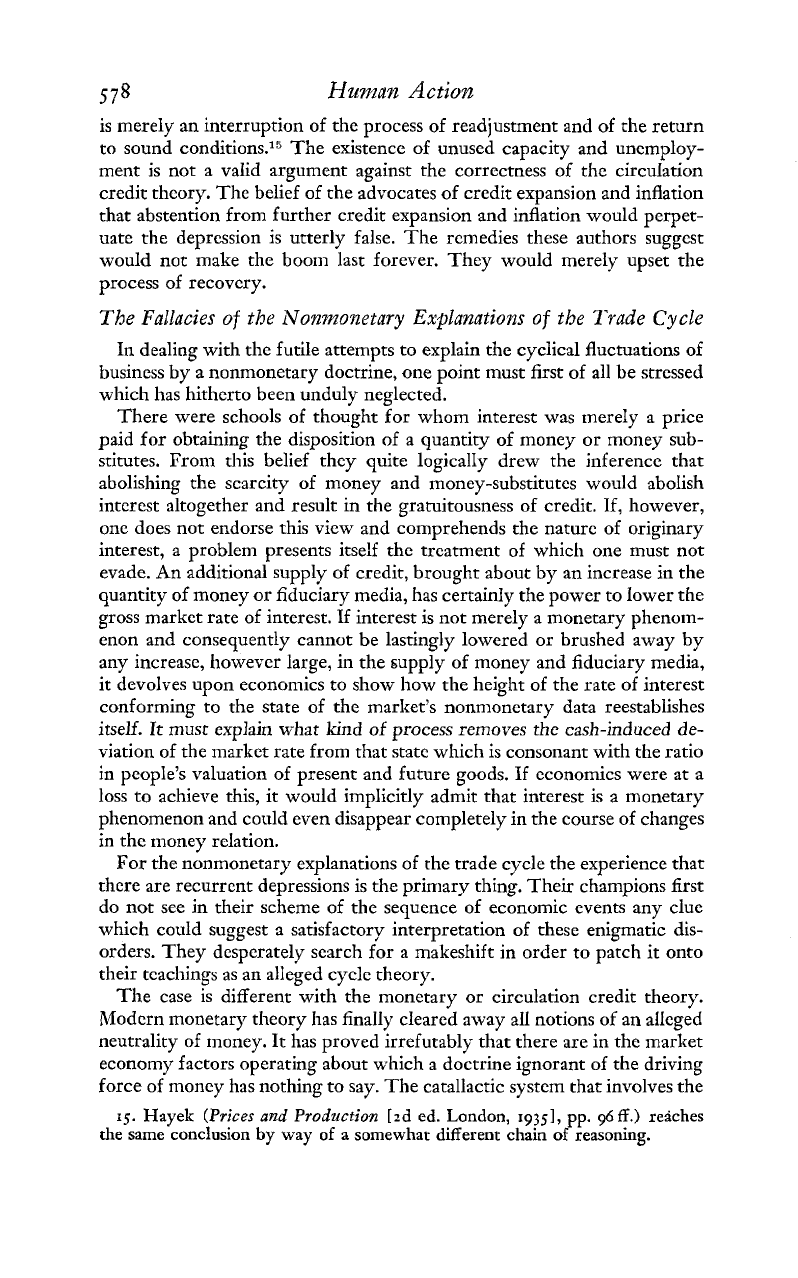
578
Human
Action
is merely an interruption of the process of readjustment and of the return
to sound conditions.15 The existence of unuscd capacity and unemploy-
ment is not a valid argument against the correctness of the circulation
credit theory. The belief of the advocates of credit expansion and inflation
that abstention from further credit expansion and inflation would perpet-
uate the depression is utterly false. The remedies these authors suggest
would not make the boom last forever. They would merely upset the
process of recovery.
The Fallacies
of
the Nonmonetary Explanations
of
the Trade Cycle
In dealing with the futile attempts to explain the cyclical fluctuations of
business by a nonmonetary doctrine, one point must first of all be stressed
which has hitherto been unduly neglected.
There were schools of thought for whom interest was merely a price
paid for obtaining the disposition of a quantity of money or money sub-
stitutes. From this belief they quite logically drew the inference that
abolishing the scarcity of money and money-substitutes would abolish
interest altogether and result in the gratuitousness of credit. If, however,
one does not endorse this view and comprehends the nature of originary
interest, a problem presents itself the treatment of which one must not
evade. An additional supply of credit, brought about by an increase in the
quantity of money or fiduciary media, has certainly the power to Iower the
gross market rate of interest. If interest is not merely a monetary phenorn-
enon and consequently cannot be lastingly lowered or brushed away by
any increase, however large, in the supply of money and fiduciary media,
it devolves upon economics to show how the height of the rate of interest
conforming to the state of the market's nonmonetary data reestablishes
itself.
It
must explain what
kind
of process removes the cash-induced de-
viation of the market rate from that state which is consonant with the ratio
in people's valuation of present and future goods.
If
economics were at a
loss to achieve this, it would implicitly admit that interest is a monetary
phenomenon and could even disappear completely in the course of changes
in the money relation.
For the nonmonetary explanations of the trade cycle the experience that
there are recurrent depressions is the primary thing. Their champions first
do not see in their scheme of the sequence of economic events any clue
which could suggest a satisfactory interpretation of these enigmatic dis-
orders. They desperately search for a makeshift in order to patch it onto
their teachings as an alleged cycle theory.
The case is different with the monetary or circulation credit theory.
Modern monetary theory has finally cleared away all notions of an aIIeged
neutrality of money. It has proved irrefutably that there are in the market
economy factors operating about which a doctrine ignorant of the driving
force of money has nothing to say. The catallactic system that involves the
15.
Hayek
(Prices
and
Production
[zd
ed.
London,
19351,
pp.
96ff.)
reaches
the same conclusion by way of
a
somewhat different chain
of
reasoning.
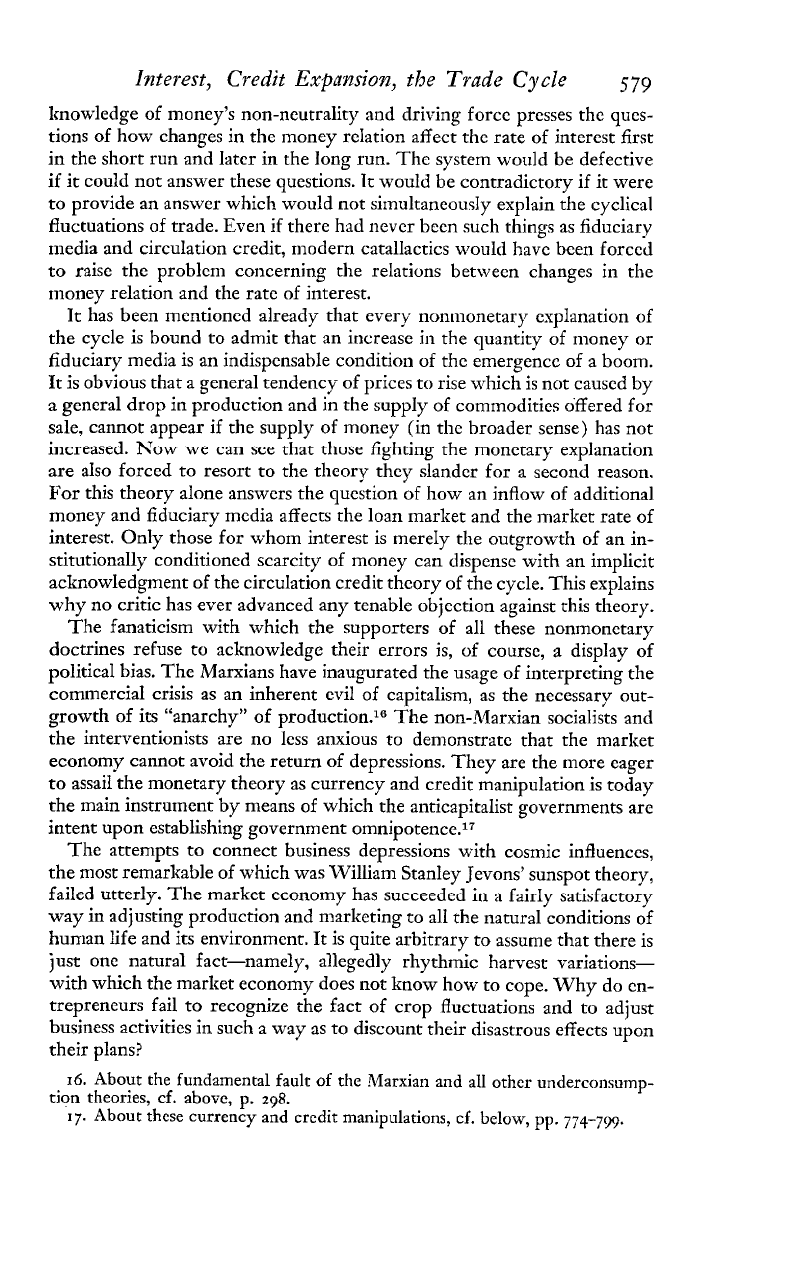
Interest, Credit
Expansion,
the
Trade Cycle
579
ltnowledge of money's non-neutrality and driving force presses the ques-
tions of how changes in the money relation affect the rate of interest first
in the short run and later in the long run. The system would be defective
if it could not answer these questions. It would be contradictory if it were
to provide an answer which would not simultaneousIy explain the cyclical
Auctuations of trade. Even if there had never been such things as fiduciary
media and circulation credit, modern catallactics would have been forced
to raise the problem concerning the relations between changes in the
money relation and the rate of interest.
It has been mentioned already that every nonmonetary explanation of
the cycle is bound to admit that an increase in the quantity of money or
fiduciary media is an indispensable condition of the emergencc of a boom.
It is obvious that a general tendency of prices to rise which is not caused by
a general drop in production and in the supply of comrnoditics offered for
sale. cannot appear if the supply of money (in the broader sense) has not
increased. Now we can see that those fighting the monetary explanation
are also forced to resort to the theory they slander for a second reason.
For this theory alone answers the question of how an inflow of additional
money and fiduciary media affects the loan market and the market rate of
interest. Only those for whom interest is rnereIy the outgrowth of an in-
stitutionally conditioned scarcity of money can dispcnsc with an implicit
acknowledgment of the circulation credit theory of the cycle. This explains
why no critic has ever advanced any tenable objection against this theory.
The fanaticism with which the supporters of all these nonmonetary
doctrines refuse to acknowledge their errors is, of coursc, a display of
political bias. The Marxians have inaugurated the usage of interpreting the
commercial crisis as an inherent evil of capitalism, as the necessary out-
growth of its "anarchy" of production.1° The non-Marxian socialists and
the interventionists are no less anxious to denlonstrate that the market
economy cannot avoid the return of depressions. They are the more eager
to assail the monetary theory as currency and credit manipulation is today
the main instrument by means of which the anticapitalist governments are
intent upon cstablishing government omnipotence.l7
The attempts to connect business depressions with cosmic influences,
the most remarkable of which was William Stanley Jevons' sunspot theory,
failed utterly. The market economy has succeeded in a fairIy satisfactory
way in adjusting production and marketing to all the natural conditions of
human life and its environment. It is quite arbitrary to assume that there is
just one natural fact-namely, allegedly rhythmic harvest variations-
with which the market economy does not know how to cope. Why do cn-
trepreneurs fail to recognize the fact of crop fluctuations and to adjust
business activities in such a way as to discount their disastrous effects upon
their plans?
16.
About the fundamental fault of the Marxian and all other underconsump-
tion theories, cf. above,
p.
298.
17.
About these currency and credit manipulations, cf. below,
pp.
774-799.
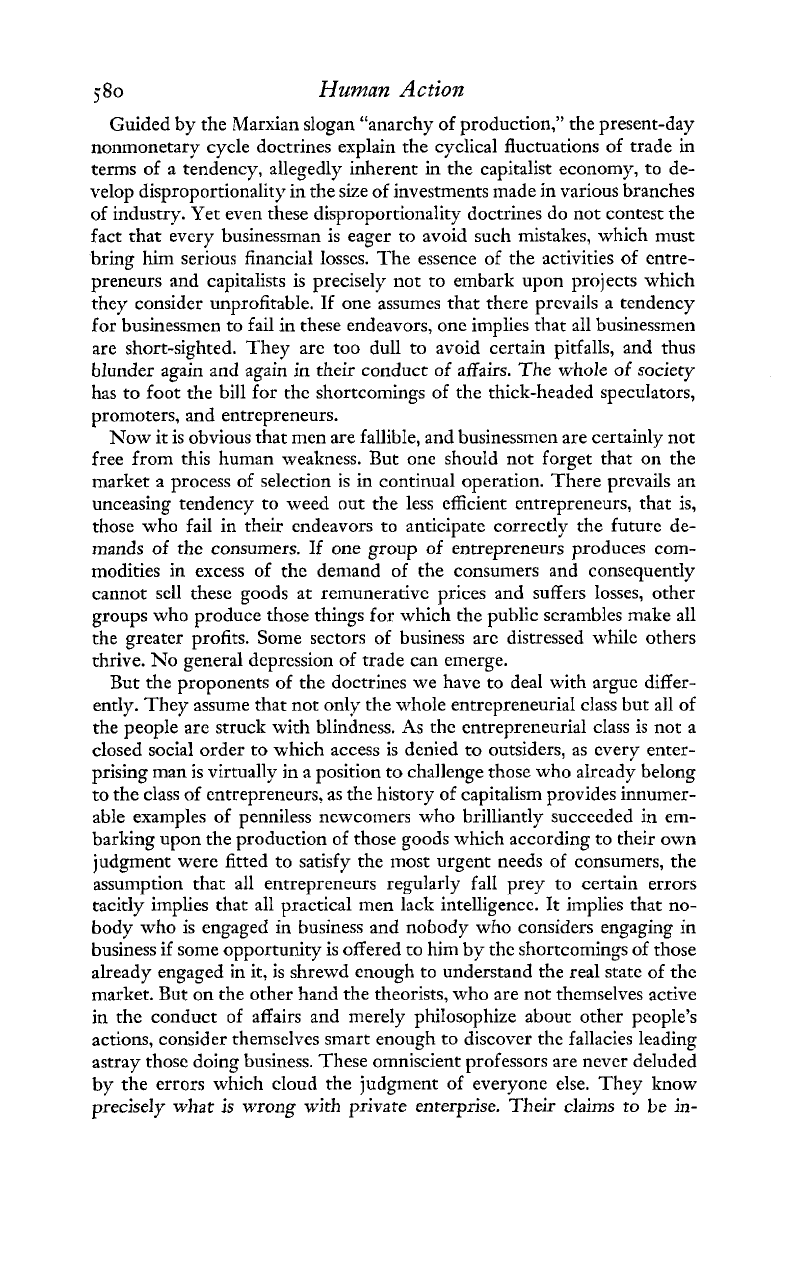
j80
Human
Action
Guided by the Marxian slogan "anarchy of production," the present-day
nonmonetary cycle doctrines explain the cyclical fluctuations of trade in
terms of a tendency, allegedly inherent in the capitalist economy, to de-
velop disproportionality in the size of investments ~nade in various branches
of industry. Yet even these disproportionality doctrines do not contest the
fact that every businessman is eager to avoid such mistakes, which must
bring him serious financial losses. The essence of the activities of entre-
preneurs and capitalists is precisely not to embark upon projects which
they consider unprofitable. If one assumes that there prevails a tendency
for businessmen to fail in these endeavors, one implies that all businessmen
are short-sighted. They are too dull to avoid certain pitfalls, and thus
blunder again and again in their conduct of affairs. The whole of society
has to foot the bill for the shortcomings of the thick-headed speculators,
promoters, and entrepreneurs.
Now it is obvious that men are fallible, and businessmen are certainly not
free from this human weakness. But one should not forget that on the
market a process of selection is in continual operation. There prevails an
unceasing tendency to weed out the less efficient entrepreneurs, that is,
those who fail in their endeavors to anticipate correctly the future de-
mands of the consumers.
If
one group of entrepreneurs produces com-
modities in excess of the demand of the consumers and consequently
cannot sell these goods at remunerative prices and suffers losses, other
groups who produce those things for which the public scrambles make all
the greater profits. Some sectors of business are distressed while others
thrive. hTo general depression of trade can emerge.
But the proponents of the doctrines we have to deal with arguc differ-
ently. They assume that not only the whole entrepreneuriaI class but all of
the people are struck with blindness. As the entrepreneurial class is not a
closed social order to which access is denied to outsiders, as every enter-
prising man is virtually in
a
position to challenge those who already belong
to the class of entrepreneurs. as the history of capitalism provides innumer-
able examples of penniless newcomers who brilliantly succeeded in em-
barking upon the production of those goods which according to their own
judgment were fitted to satisfy the most urgent needs of consumers, the
assumption that all entrepreneurs regularly fall prey to certain errors
tacitly implies that all practical Inen lack intelligence. It implies that no-
body who is engaged in business and nobody who considers engaging in
business if some opportunity is offered to him by the shortcomings of those
already engaged in it, is shrewd enough to understand the real state of the
market.
But
on the other hand the theorists, who are not themselves active
in the conduct of affairs and merely phiIosophize about other people's
actions, consider themselves smart enough to discover the fallacies leading
astray those doing business. These omniscient professors are never deluded
by the errors which cloud the judgment of everyone else. They know
precisely
what
is
wrong with private enterprise. Their claims ro be in-

Interest, Credit Expansion,
the
Trade
Cycle
581
vested with dictatorial powers to control business are therefore fully
justified.
The most amazing thing about these doctrines is that they furthermore
imply that businessmen, in their littleness of mind, obstinately cling to
their erroneous procedures in spite of the fact that the scholars have long
since unmasked their faults. Although every textbook explodes them, the
businessmen cannot help repeating them. There is manifestly no means to
prevent the recurrence of economic depression other than to entrust-in
accordance with Plato's utopian ideas-supreme power to the philosophers.
Let us examine briefly the two most popular varieties of these dispro-
portionality doctrines.
There is first the durable goods doctrine. These goods retain their ser-
viceableness for some time. As long as their life period lasts, the buyer who
has acquired a piece abstains from replacing it by the purchase of a new
one. Thus, once all people have made their purchases, the demand for new
products dwindles. Business becomes bad. A revival is possible only when,
after the lapse of some time, the old houses, cars, refrigerators, and the like
are worn out, and their owners must buy new ones.
However, businessmen are as a rule more provident than this doctrine
assumes. They are intent upon adjusting the size of their production to the
anticipated size of consumers' demand. The bakers take account of the fact
that every day a housewife needs a new loaf of bread, and the manufac-
turers of coffins take into account the fact that the total annual sale of
coffins cannot exceed the number of people deceased during this period.
The machine industry reckons with the average "life" of its products no
less than do the tailors, the shoemakers, the manufacturers of motorcars,
radio sets, and refrigerators, and the construction firms. There are, to be
sure, always promoters who in a mood of deceptive optimism are prone to
overexpand their enterprises. In the pursuit of such projects they snatch
away factors of production from other plants of the same industry and
from other branches of industry. Thus their overexpansion results in a
relative restriction of output in other fields. One branch goes on expand-
ing while others shrink until the unprofitability of the former and the
profitability of the latter rearranges conditions. Both the preceding boon)
and the following slump concern only a part of business.
-.
1
he second variety of these dlsproport~onallty doctrines is known as the
acceleration principle.
A
temporary rise in the demand for a certain com-
modity results in increased production of the commodity concerned. If,
then, demand later drops again, the investments made for this expansion
of production appear as malinvestments. This becomes especially perni-
cious in the field of durable producers' goods. If the demand for the con-
sumers' good
n
increases by
10
per cent, business increases the equipment
p
required for its production by
10
per cent. The resulting rise in the demand
for
p
is the more momentous in proportion to the previous demand for
p,
the longer the duration of serviceableness of a piece of
p
is and the smaller

consequently the previous demand for the replacement of worn-out pieces
of
p
was. If the life of a piece of
p
is
I
o years, the annual demand for
p
for
replacement was
10
per cent of the stock of
p
previously employed by the
industry. The rise of
10
per cent in the demand for
a
doubles therefore the
demand for
p
and results in a roo per cent expansion in the equipment
r
needed for the production of
p.
If then the demand for
a
stops increasing,
50
per cent of the production capacity of
r
remains idle. If the annual
in-
crease in the demand for
a
drops from
10
per cent to
5
per cent,
25
per cent
of the production capacity of
r
cannot be used.
The fundamental error of this doctrine is that it considers entrepreneur-
ial activities as a blindly automatic response to the momentary state of de-
mand. Whenever demand increases and renders a branch of business more
profitable, production facilities are supposed instantly to expand in pro-
portion. This view is untenable. Entrepreneurs often err. They pay heavily
for their errors. But whoever acted in the way the acceleration principle
describes would not be an entrepreneur, but a soulless automaton. Yet the
real entrepreneur is a
s~eculiltor,~~
a man eager to utilize his opinion about
the future structure of the market for business operations promising prof-
its. This specific anticipative understanding of the conditions of the un-
certain future defies any rules and systematization. It can be neither taught
nor learned. If it were different, everybody could embark upon entre-
preneurship with the same prospect of success. What distinguishes the
successful entrepreneur and promoter from other people is precisely the
fact that he does not Iet himself be guided by what was and is, but arranges
his affairs on the ground of his opinion about the future. He sees the past
and the present as other people do; but he judges the future in a different
way. In his actions he is directed by an opinion about the future which
deviates from those held by the crowd. The impulse of his actions is that
he appraises the factors of production and the future prices of the com-
modities which can be produced out of them in a different way from other
people. If the present structure of prices renders very profitable the busi-
ness of those who are today selling the articles concerned, their production
will expand only to the extent that entrepreneurs believe that the favorable
market constellation will last long enough to make new investments pay.
If
entrepreneurs do not expect this, even very high profits of the enter-
prises aiready operating wiii not bring about an expansion. It
IS
exactly thls
reluctance of the capitalists and entrepreneurs to invest in lines which they
consider unprofitable that is violently criticized by people who do not
comprehend the operation of the market economy. Technocratically
minded engineers complain that the supremacy of the profit motive pre-
vents consumers from being amply supplied with all those goods with
which technological knowledge could provide them. Demagogues cry out
against the greed of capitalists intent upon preserving scarcity.
18.
It
is
noteworthy that the same term is employed to signify the premedita-
tion and the ensuing actions of the promoters and cntreprcneurs and the purely
academic rcasoning of theorists that does not directly result
in
any action.
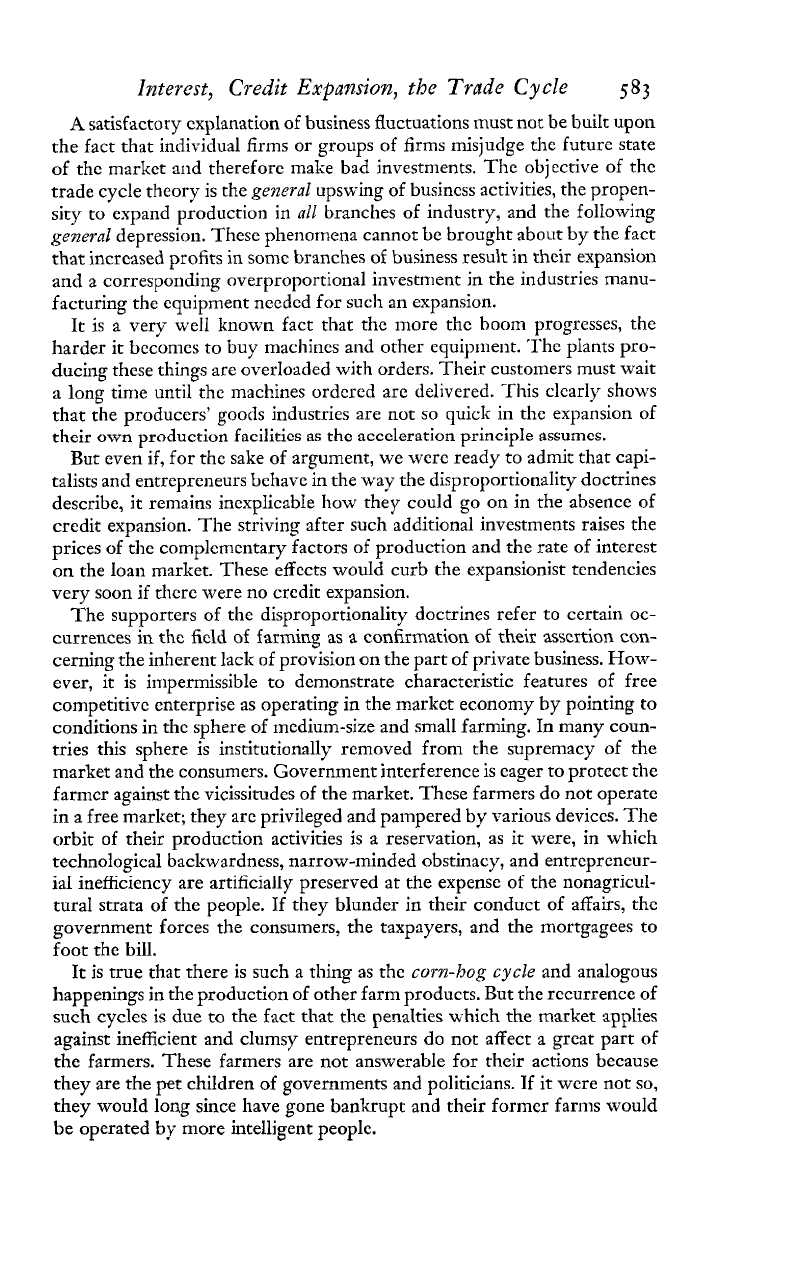
Interest,
Credit
Expansion,
the
Trade Cycle
583
A
satisfactory explanation of business fluctuations must not be built upon
the fact that individual firms or groups of
firms
misjudge the future state
of the market and therefore make bad investments. The objective of the
trade cycle theory is the
general
upswing of business activities, the propen-
sity to expand production in
all
branches of industry, and the following
general
depression. These phenomena cannot be brought about by the fact
that increased profits in some branches of business result in their expansion
and a corresponding overproportional investment in the industries manu-
facturing the equipment needed for such an expansion.
It
is
a very well known fact that the more the boom progresses, the
harder it becomes to buy machines and other equipment. The plants pro-
ducing these things are overloacled with orders. Their customers must wait
a long time until the machines ordered are delivered. This clearly shows
that the producers' goods industries are not so quick in the expansion of
their own production facilities as the acceleration principle assumes.
But even if, for the sake of argument, we were ready to admit that capi-
talists and entrepreneurs behave in the way the disproportionality doctrines
describe, it remains inexplicabIe how they could go on in the absence of
credit expansion. The striving after such additional investments raises the
prices of the complementary factors of production and the rate of interest
on the loan market. These effects would curb the expansionist tendencies
very soon if there were no credit expansion.
The supporters of the disproportionality doctrines refer to certain oc-
currences in the field of farming as
a
confirmation of their assertion
con-
cerning the inherent lack of provision on the part of private business. How-
ever, it is impermissible to demonstrate characteristic features of free
competitive enterprise as operating in the market economy by pointing to
conditions in the sphere of mcdium-size and small farming. In many coun-
tries this sphere is institutionally removed from the supremacy of the
market and the consumers. Government interference is eager to protect the
farmer against the vicissitudes of the market. These farmers do not operate
in
a
free market; they are privileged and pampered by various devices. The
orbit of their production activities is a reservation, as it were, in which
technological backwardness, narrow-minded obstinacy, and entrepreneur-
ial inefficiency are artificially preserved at the expense of the nonagricul-
turd strata of the people. If they blunder in their conduct of affairs, the
government forces the consumers, the taxpayers, and the mortgagees to
foot the bill.
It
is true that there is such a thing as the
corn-hog
cycle
and analogous
happenings in the production of other farm products. But the recurrence of
such cycles is due to the fact that the penalties which the market applies
against inefficient and clumsy entrepreneurs do not affect a great part of
the farmers. These farmers are not answerable for their actions because
they are the pet children of governments and politicians. If it were not so,
they would long since have gone bankrupt and their former farms would
be operated by more intelligent people.
